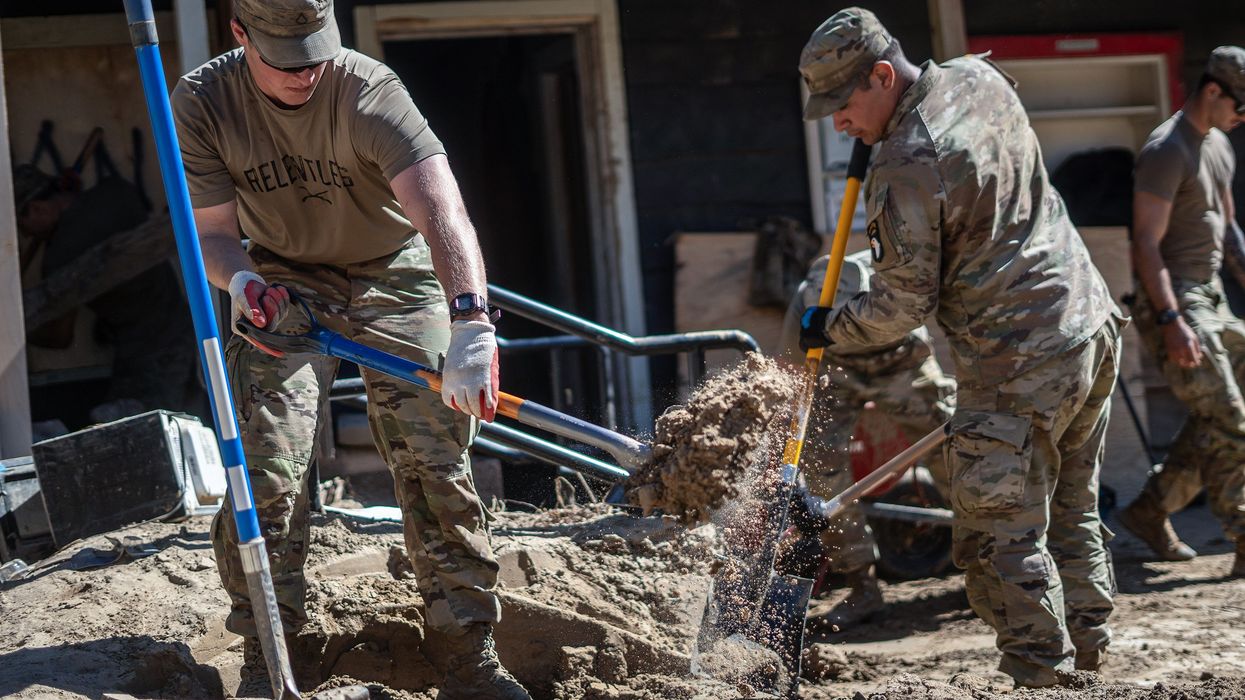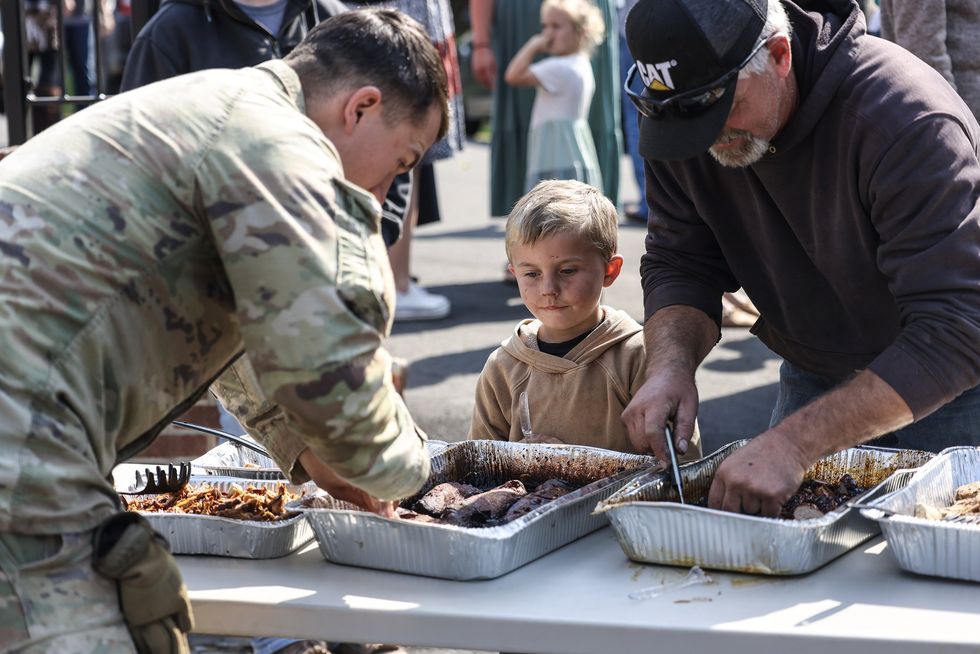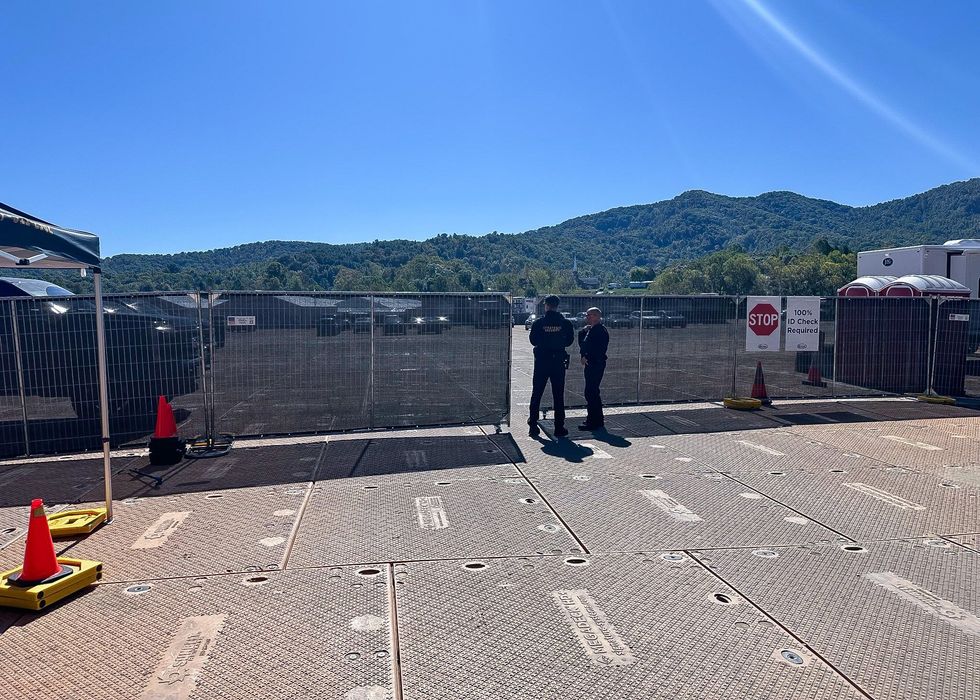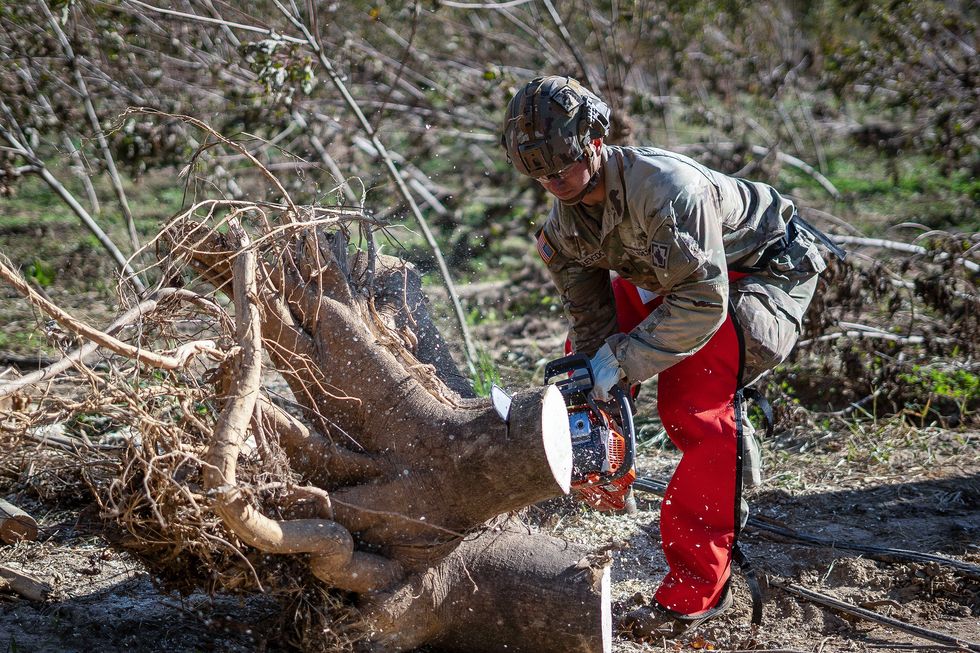
Army soldiers clear roads in Chimney Rock, North Carolina. Photo by Sgt. Dominic Acuna/U.S. Army

FEMA says it has approved $102 million in disaster aid for households in 39 counties.
SWANNANOA, North Carolina — Officials from the U.S. Army and the Federal Emergency Management Agency said despite widely disseminated accusations on social media, they are and have been performing rescues and providing humanitarian assistance for weeks across Western North Carolina in the wake of Hurricane Helene.
More than 1,500 troops from the Army’s XVIII Airborne Corps are working across the hardest-hit areas delivering food, water, and household supplies, clearing storm debris, and searching for the missing. They joined more than 3,600 National Guard members providing Hurricane Helene relief across multiple states.
The Army expanded its presence at the veteran-run Savage Freedoms Relief Operations center with 100 members of the 101st Airborne. The volunteer center has integrated its operations so well with the Army and National Guard that it received a visit October 16 from Lt. Gen. Christopher Donahue, commanding general of the XVIII Airborne Corps.
Soldiers and airmen from the 82nd Airborne Division, the 101st, and the 3rd Expeditionary Sustainment Command fanned out across Western North Carolina delivering humanitarian aid, removing storm debris, working to get water service re-established, and assisting local businesses to clean up from Hurricane Helene’s devastating floods and mudslides.
'It is a grant, not a loan. I cannot say that enough.'
“So the most important thing for us is getting as many people as we can to as many places as we can, as fast as we can to help the ones in need,” said Staff Sgt. Corey Reese of XVIII Corps public affairs in an interview with Blaze News.
Capt. Steven Cochrane, the North Carolina National Guard liaison officer assigned to Buncombe County surrounding Asheville, said the Guard did planning before the storm made landfall on September 26 and adjusted as Helene kept up its fury.
“We did anticipate some hard-hit areas, but just the amount, of volume, of devastation was unanticipated,” Cochrane said. “However, the National Guard did immediately do the assessments. The day of the storm and the day after, they started to plus-up because it started to look worse and worse as it came through. So the mobilization was quick from my standpoint. We definitely mobilized.“
The National Guard is working with FEMA to distribute thousands of pallets of supplies from massive warehouse complexes across the region. Officials from FEMA said the agency has provided more than $100 million in disaster assistance in North Carolina and brought in 1,400 staff to do search and rescue and process aid applications for those hardest hit by Hurricane Helene.
“We had an incident management team in Raleigh on September 26,” Dan Shulman, a FEMA senior external affairs specialist, told Blaze News. “Since then we’ve been moving more people, more commodities into the state to get to where we are now, which is staff across the state in all of the declared counties working with North Carolinians every day.”
Blaze News visited a FEMA supply chain warehouse stocked with pallets of supplies in Weaverville, North Carolina. National Guard personnel are staffing the warehouse, managing and moving out supplies.

“We've had an ever-increasing number of staff here every single day since September 26,” Shulman said. “The number has only gotten bigger. We’re at around 1,400 as of today.”
According to FEMA's most recent statistics, more than $102 million has been approved in emergency aid for North Carolina storm victims in 39 counties and tribal members of the Eastern Band of Cherokee Indians. That includes nearly $84 million for “serious disaster-related needs like moving expenses, childcare and disaster-related dental, medical or funeral expenses.”
FEMA officials have performed 14,400 home inspections. The agency is providing free temporary hotel stays for more than 2,000 households through transitional sheltering assistance.
One of FEMA’s most pressing tasks has been to counter what Shulman said are rumors published on social media that the agency is seizing volunteer aid deliveries and that financial aid to disaster survivors has to be repaid like a loan.
“Number one, we’re not confiscating commodities,” Shulman said. “Number two, if you register with FEMA, it does not give us the ability to take your home. All of our assistance is grants, not loans. That’s the big one that we believe is keeping people from registering for assistance.”
Shulman urged storm survivors to register for aid by calling (800) 621-3362, using the FEMA website at www.disasterassistance.gov, or visiting one of the 10 FEMA disaster recovery centers operating in affected North Carolina communities. More centers will open soon.
Survivors who get an aid-denial notice should stay in contact with FEMA, Shulman said. Sometimes a denial requires something as simple as supplying additional information to the agency, he said.
“If you were affected by the disaster, register with us,” Shulman said. “Stay in touch with us and check on your neighbors and make sure they’re doing the same thing.”
'I feel like what we're doing out here has spoken for itself immensely.'
The construction of several FEMA staff housing centers has caused wild speculation on social media that there is some nefarious purpose involved. The opening of a FEMA responder village in Candler, North Carolina, west of Asheville resulted in voluminous speculation and media drone overflights to determine what the site is being used for.
The centers are designed to house FEMA staff and contractors so they can move out of hotel rooms to free up space for displaced families, Josh Wert, director of FEMA’s responder support branch, told Blaze News in an interview at the Candler location.
The housing centers have single units for FEMA staff. Each one occupied by an employee will free up a hotel room that can be used by a family, Wert said. Despite rampant rumors on social media, the housing centers are not internment camps or some kind of accommodations for illegal immigrants, he said.
“Our concern with contracting with hotels here is taking away rooms from the survivors,” Wert said. “So we're trying to stay out of that, but we try to set these up so that everywhere they need to work, they can come back to one of our locations within a 60-minute drive time.”
The responder villages offer lodging, showers, electricity, medical care, food, dining, parking, “just anything someone would need if they had to leave their home and go out and support survivors,” Wert said.
“We had to ensure that there was capable lodging for the responders to come in before they could support the survivors,” he said.
Responder villages are built “so that our staff are not a burden to the community,” Shulman said. “So as people drive by and say, ‘What is this?’ We set this up so that our staff are not taking up hotel rooms from disaster survivors. These are small, single lodging [units]. It’s a small single room that I’ve stayed in so that a family of four can stay in a hotel room.”

Wert said his team has been on the ground in North Carolina for 25 days but began preparing for Hurricane Helene before the storm made landfall in Florida.
“We initially mobilized into the regional office into Florida and into North Carolina,” Wert said. “I had people in downtown Asheville within two days of the storm starting the coordination and communication, trying to find pieces of land like this that we could come in and set up these villages.
“We did have boots on the ground in Asheville early on, working with the state,” he said. “I do know that there are disaster recovery centers up that FEMA is at right now. There are disaster survivor assistance employees out canvassing the local area. So FEMA is here.”
The FEMA and military officials who spoke to Blaze News downplayed recent suggestions that militia groups are causing trouble for government relief efforts. One arrest was made this week regarding threats, but the militia story was debunked quickly.
“Everyone that I’ve encountered has been appreciative of the efforts of people here to help them,” Shulman said. “But those things [stories] were out there, but everyone that I’ve encountered has been appreciative and thankful of the work that people are doing to help them.”
Reese said the stories about alleged militias did not affect the operations of military units.
“The assessment was potential militia activity, and then the one individual got arrested and that got debunked essentially immediately,” Reese said. “We never withdrew. We never withdrew from that county ourselves. Active-duty soldiers never left that county.”
Reese said survivors have been grateful for the help being provided by the U.S. military.
“I feel like what we're doing out here has spoken for itself immensely,” he said. “Every town we go to, there’s been no negative reception. We haven't been turned around, asked to leave, anything like that.”

The XVIII Airborne Corps sent 30 soldiers to help a small business owner clean out mud and silt from his water-damaged building, Reese said.
“Some of these businesses are just one individual who has their entire shop gone,” he said. “And to have 30 soldiers in there clearing out a room instead of one — even an elderly person, one elderly shop owner — and instead of them having to do it all by themselves, we have 30 soldiers going there at one time and the whole shop is cleared out in a day.”
The active-duty military and National Guard have brought in heavy equipment that has been used for rescue operations, debris clearance, water purification, fuel storage, high-water transport, medical missions, and heavy construction.
Bulldozers, excavators, skid steers, and other engineering equipment have been used to clear emergency routes. Chinook helicopters from the National Guard and the 82nd Combat Aviation Brigade provide heavy-lift capabilities and high capacity for delivering relief supplies for survivors and farm animals.
Shulman said FEMA plans to stay in the region for the long haul required to help with a full recovery from the hurricane. Even after the search-and-rescue teams move on to other assignments, more public assistance teams will move in.
“We have a housing task force that is specifically focused on identifying those intermediate and long-term housing solutions for North Carolinians,” he said. “They’re experts in this subject, and that’s all they’re focused on.”
Hear more on the subject from the "Blaze News Tonight" team in the video below:
Like Blaze News? Bypass the censors, sign up for our newsletters, and get stories like this direct to your inbox. Sign up here!
Steve Baker
Contributor